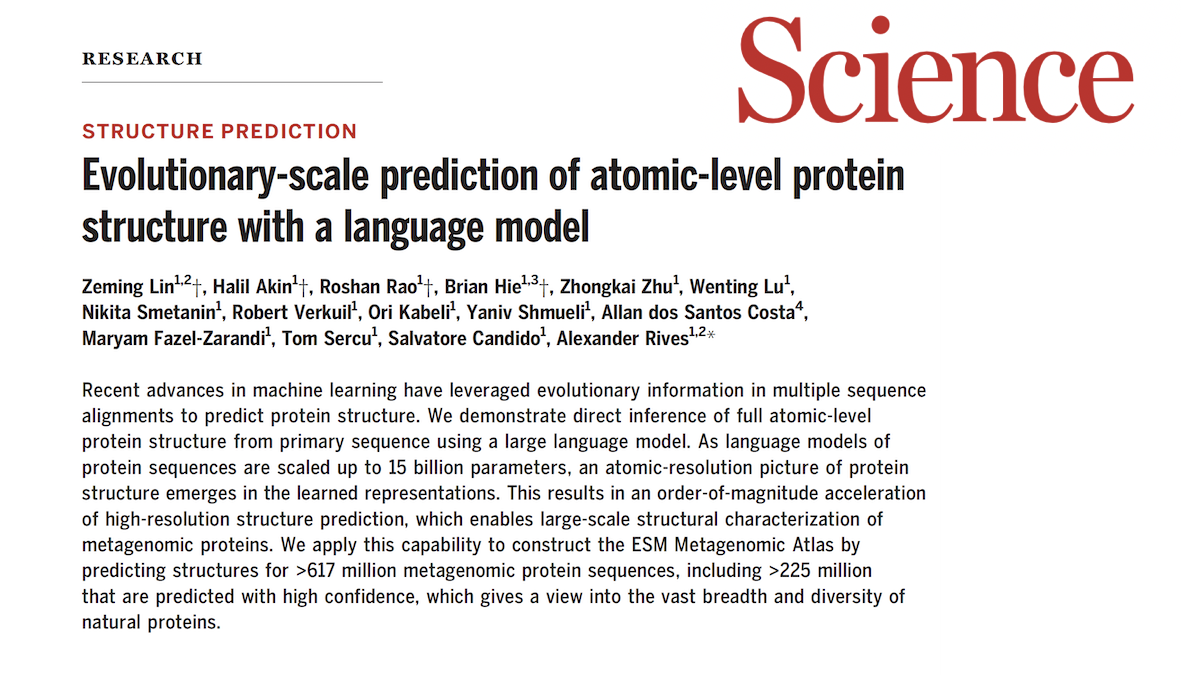SCIENCE. RESEARCH ARTICLE. STRUCTURE PREDICTION.
DOWNLOAD PDF
Speedy structures from single sequences
Machine learning methods for protein structure prediction have taken advantage of the evolutionary information present in multiple sequence alignments to derive accurate structural information, but predicting structure accurately from a single sequence is much more difficult. Lin et al. trained transformer protein language models with up to 15 billion parameters on experimental and high-quality predicted structures and found that information about atomic-level structure emerged in the model as it was scaled up. They created ESMFold, a sequence-to-structure predictor that is nearly as accurate as alignment-based methods and considerably faster. The increased speed permitted the generation of a database, the ESM Metagenomic Atlas, containing more than 600 million metagenomic proteins. —MAF
Abstract
Recent advances in machine learning have leveraged evolutionary information in multiple sequence alignments to predict protein structure. We demonstrate direct inference of full atomic-level protein structure from primary sequence using a large language model. As language models of protein sequences are scaled up to 15 billion parameters, an atomic-resolution picture of protein structure emerges in the learned representations. This results in an order-of-magnitude acceleration of high-resolution structure prediction, which enables large-scale structural characterization of metagenomic proteins. We apply this capability to construct the ESM Metagenomic Atlas by predicting structures for >617 million metagenomic protein sequences, including >225 million that are predicted with high confidence, which gives a view into the vast breadth and diversity of natural proteins.
Conclusions
Fast and accurate computational structure prediction has the potential to accelerate progress toward an era in which it is possible to understand the structure of all proteins discovered in gene sequencing experiments. Such tools promise insights into the vast natural diversity of proteins, most of which are discovered in metagenomic sequencing. To this end, we have completed a large-scale structural characterization of metagenomic proteins that reveals the predicted structures of hundreds of millions of proteins, millions of which are expected to be distinct in comparison to experimentally determined structures.
As structure prediction continues to scale to larger numbers of proteins, calibration becomes critical because, when the throughput of prediction is limiting, the accuracy and speed of the prediction form a joint frontier in the number of accurate predictions that can be generated. Very high-confidence predictions in the metagenomic atlas are expected to often be reliable at a resolution sufficient for insight similar to experimentally determined structures, such as into the biochemistry of active sites (
56). For many more proteins for which the topology is predicted reliably, insight can be obtained into function through remote structural relationships that could not be otherwise detected with sequence.
The emergence of atomic-level structure in language models shows a high-resolution picture of protein structure encoded by evolution into protein sequences that can be captured with unsupervised learning. Our current models are very far from the limit of scale in parameters, sequence data, and computing power that can in principle be applied. We are optimistic that as we continue to scale, there will be further emergence. Our results showing the improvement in the modeling of low depth proteins point in this direction.
ESM-2 results in an advance in speed that in practical terms is up to one to two orders of magnitude, which puts far larger numbers of sequences within reach of accurate atomic-level prediction. Structure prediction at the scale of evolution can open a deep view into the natural diversity of proteins and accelerate the discovery of protein structures and functions.
LEARN MORE:

